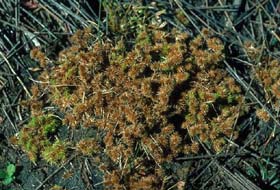A large family of some 4000 species, distributed worldwide, most of the plants being rhizomatous perennials. They are characteristic of moist habitats. In Western Australia there are some 300 species, of which 18 are naturalised. Their taxonomy is very confused and there are few specialist texts, making accurate identification difficult.
Carex divisa (divided sedge) is of Eurasian origin and spreads by rhizomes. The bracts (modified leaves) at the base of the inflorescence do not exceed the length of the inflorescence. It is an invasive weed becoming dominant in brackish wetlands on the Swan Coastal Plain and occurs at least as far south as Busselton and Cape Naturaliste. There are six other species of Carex native to Western Australia.

Carex divisa
. RR
Cyperus
is a
genus of tufted plants, 46 native and eight naturalised in
Western Australia.
C.
brevifolius
(Mullumbimby couch) is fairly distinctive. It forms
extensive rhizomatous patches in overwatered lawns and
garden beds, occasionally in disturbed wetlands, from Perth
to north of Broome, at Beagle Bay. It has bright green,
shiny, grass-like leaves and may be mistaken for a lawn
grass until it flowers in summer (often only on the margin
of mown areas).

Cyperus
brevifolius
. RR
C. compressus is an annual weed of lawns and wastelands near settlements in the Kimberley. It has triangular stems and very narrow, thread-like leaves. Both species are worldwide weeds.

C.
compressus
. RR
C. congestus (dense flat-sedge) from South Africa, C. eragrostis (umbrella sedge) PP from South America, C. polystachyos native to eastern Australia, C. tenuiflorus (scaly sedge) and C. vorsteri, both from southern Africa, are all similar and easily confused. They occur in similar habits (disturbed wetlands from the Pilbara to Albany), form grass-like clumps and have triangular stems bearing umbrella-like inflorescences.

C.
congestus
. PH
C. eragrostis has broad inflorescences and one stamen per flower. C. polystachyos has two stamens per flower while the remainder have three stamens per flower. C. congestus has broad inflorescences,C. tenuiflorus slender ones. These three have their main flowering period in summer, but also flower again in early winter. C.vorsteri is 1.5m tall and flowers in spring. It has been found in disturbed wetlands at Kalamunda.

C.
eragrostis
. PH

C.
tenuiflorus
. PH
C. involucratus is a garden ornamental found in some wetlands around Perth. It has a similar growth habit to the above species, except that it is tall - similar to C. vorsteri - leafier, and the stems are cylindrical. Native to North Africa.C. laevigatus can be distinguished by its clumps of triangular stems with the leaves reduced to papery sheaths. It has two style branches. (The similar native C.gymnocaulos has three style branches.) It flowers in summer in disturbed wetlands in the Metropolitan area, Port Gregory and Augusta. A cosmopolitan weed.
C.
involucratus
. GK
C. papyrus (papyrus) produces triangular stems up to 3m tall, from which hang delicate masses of green thread-like flowering stems. It is spreading from plantings at Yanchep, North Lake and Lesmurdie Falls. Native to Egypt and famous for its role in the manufacture of early paper.

C. papyrus
. RR
C. rotundus (nut grass) is listed as one of the world's worst weeds. A perennial, up to 60cm in height, it spreads by rhizomes and produces characteristic tubers. A frequent weed of horticulture in Perth and a lawn, garden and wasteland weed in the Perth area northward. Native to the Pilbara and Kimberley. C. tenellus (tiny flat-sedge) is an annual, sometimes reaching 12cm tall. It favours open, winter-wet soils and is a widespread weed of granite rocks, woodlands, wetlands and roadsides from Geraldton to Esperance and inland areas east of Southern Cross. Flowers in spring. A native of South Africa.

C.
rotundus
. RR
Isolepis (club-rushes) is a genus with 16 species in Western Australia, two are certainly introduced, one other may be. I. hystrix is an annual, rarely exceeding 5cm in height, flowering in spring. It is becoming increasingly common in claypans on the eastern side of the Swan Coastal Plain. Native to South Africa. I. marginata is another spring-flowering annual. It forms dense tufts up to 10cm in height, with stem bases that are often reddish. It is common and widespread on winter-wet ground in the south-west. It is often considered a native, but may possibly have been introduced from South Africa.

I.
hystrix
. GK
I. prolifera (budding club-rush) is a South African perennial up to 60cm in height. It is a common weed of disturbed lakes and creeks from Perth to Albany, flowering in summer, and also at the onset of winter. It produces new plants vegetatively at the shoot tips. At Wilson's Inlet it has hybridised with I. cernua, a native species.

I.
prolifera
. GK
